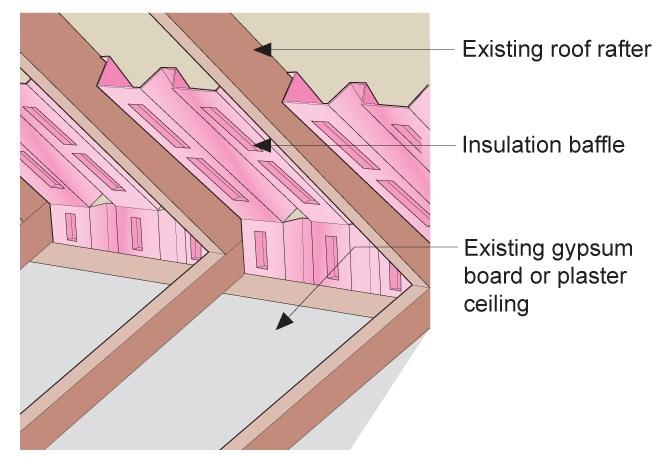

This can cause all sorts of problems, from mold to decay. When you have insulation without ventilation, though, humidity and moisture can build up. /rebates/2fp2fOwens-Corning-Raft-R-Mate-22-1-2-in-x-4-ft-Attic-Insulation-Rafter-Baffle-Proper-Vents-10-Pieces-70RM2f204848302&. Make sure the baffles keep it from butting up against the rafter bays.Īn attic needs to be insulated to keep your house warm in the winter and cool in the summer. Step 3-Replacing the InsulationĪfter you have installed every baffle, push the existing insulation back into place, or lay your new insulation. Be careful of any roofing nails that may be sticking out of the rafters or bay. Staple the edges into place with the staple gun, making sure they are lined up correctly and securely. Fit each one snuggly in the bay, with the bottom starting where the ceiling joist meets the roof rafter. You will need a baffle for each space between the rafters. Pull any existing insulation away from the edges of the attic where you will be putting up the baffles.
#Rafter baffles install#
If your roof rafters have been covered over with drywall or plywood, you will have to remove it in order to install the baffles. Simply installing raft-R-mate Attic Rafter Vents offers year-round performance and helps to prevent ice dams in winter.
#Rafter baffles skin#
Good luck with your project.Whenever you will be working around any insulation, it is important to wear your safety gear (goggles, gloves, dust mask, and coveralls) to prevent irritation to your skin and eyes. I would go with the 48" pre-made vents any brand will do as long as they are made of a foam product like expanded polystyrene. 24" may work but don't be fooled, the blowing of any insulation is messy and not a science to an exact spot, some may go into the baffle, best to get 48" and be safe and have no worries about that. Remember you need to go to the outside of the wall with insulation not just to the top plate so you want to extend the baffle quiet far into the soffit. never mind the staple length to hold them in place. They are known are also known as wind baffle, insulation baffles, rafter vents or venting chutes. Lots of bends to deal with on the make your own foam baffles. In brief, baffles are designed to provide a channel of air to flow through specific parts of your attic. Think of how long it will take you to fashion a baffle so it's strong enough and also how you staple it to the sheathing. It has been stated, to just use two baffles, I agree with that, making your own will cost you more than buying them and you don't need 1/2" foam to work.

By the time you get the baffle into the soffits, install wind wash blockers to stop the blown in insulation from going into the soffits and wind blowing your blockers back you may end up with a very little amount showing. SmartBaffle will keep the insulation away from blocking the intake air from the soffit. SmartBaffle is designed for use with fiberglass insulation, loose fill insulation or spray foam insulation. The length depends on your roof pitch, (shallow requires more length up the rafters to compensate for the low pitch and I wouldn't go much less than 48" anyway). Each piece can be cut in half for double coverage at the eaves area to guard against insulation blockage in the open attic rafter spaces. Standard length is 48" to go into he eves and extend fully to any insulation depth.


 0 kommentar(er)
0 kommentar(er)
